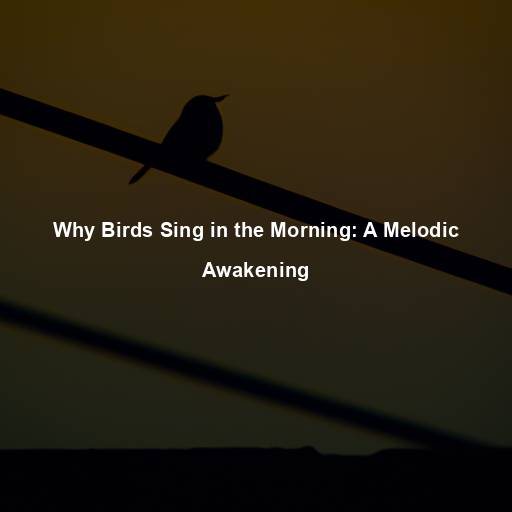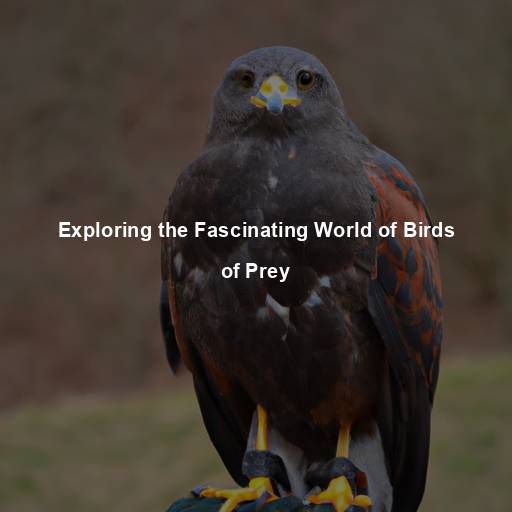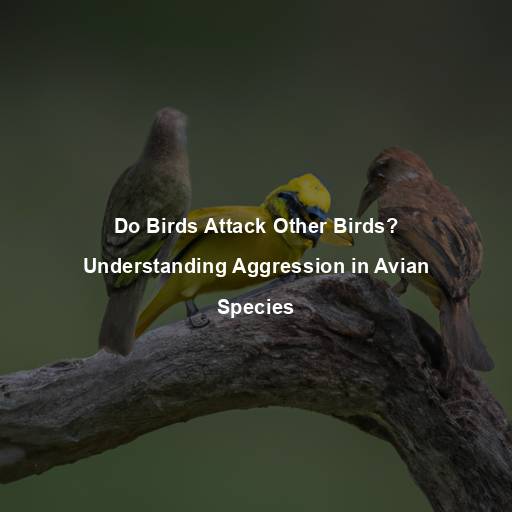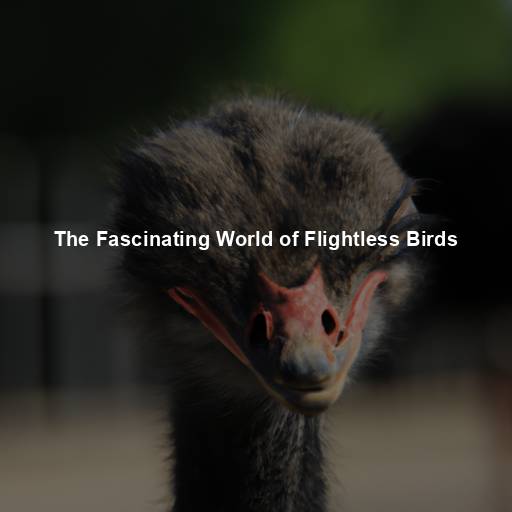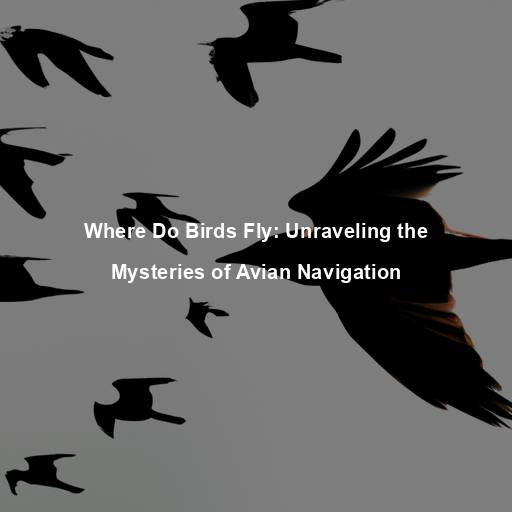Why Birds Sing in the Morning: A Melodic Awakening
Last Updated on November 20, 2023 by Evan
Contents [hide]
- 1 The Dawn Chorus: A Symphony of Nature
- 2 The Science Behind the Melodies
- 3 The Evolutionary Symphony
- 4 The Melody of Mystery
- 5 The Influence of Habitat and Season
- 6 The Emotional Impact of Birdsongs
- 7 The Mysteries That Remain
- 8 FAQs – Why Birds Sing in the Morning
- 8.1 Why do birds sing in the morning?
- 8.2 Do all bird species sing in the morning?
- 8.3 Is there a specific reason why birds sing more during spring?
- 8.4 Why do birds sing before sunrise?
- 8.5 Do male and female birds both sing?
- 8.6 Is there a specific scientific explanation for the melody in bird songs?
- 8.7 Can the timing of bird songs be affected by external factors?
The Dawn Chorus: A Symphony of Nature
The Phenomenon That Captivates Us
The early morning hours, just before the first rays of sun pierce the horizon, are filled with a magical symphony. It is a time when the air is crisp, and the world is still awakening from its slumber. And amidst this tranquility, birds take center stage, filling the air with their melodious songs. But have you ever wondered why birds sing in the morning?
The Melody of Courtship
One of the primary reasons behind the morning serenade of birds is courtship. For many species, the early hours of the day serve as the perfect time to attract a mate. The male birds use their songs to establish territory, communicate their presence to potential partners, and demonstrate their vitality and genetic fitness. The intricate melodies and complex vocalizations act as a form of advertising, allowing the male birds to showcase their prowess and charm.
The Battle for Territory
The melodious symphony of birds at daybreak is far from a mere serenade of amore. It’s a captivating declaration of boundaries and a calculated strategy for survival. As the sun stretches its golden fingers, a tangled web of competition comes alive. Each chirp, each trill, carries a clandestine message that resonates beyond the veil of twilight, asserting one’s claim over coveted resources.
The Science Behind the Melodies
The Circadian Rhythm: A Biological Alarm Clock
Birdsong in the morning is not a random occurrence but rather a result of the inherent biological clock ticking within these feathered creatures. Like humans, birds have a natural rhythm known as the circadian rhythm. This internal clock regulates their physiological and behavioral patterns, including when they sleep, wake up, eat, and sing. The circadian rhythm aligns with the rising sun, making the early morning hours the perfect time for birds to burst into song.
Hormonal Triggers
In the avian world, the command center regulating the inherent desire to serenade the world lies within the hormone testosterone. As dawn breaks and illuminates the skies, the testosterone levels embark on a journey of exuberance, setting the stage for a symphony of melodies. While male birds take the spotlight in this hormonal dance, it isn’t uncommon for their female counterparts to join the ensemble, using their captivating tunes to signal their readiness for love. This intricate connection between hormone and harmony sheds light on the bewitching morning chorus that captivates the hearts of birds and humans alike.
Environmental Factors: The Dawn Advantage
When it comes to chirping, birds are not only influenced by their inner clock but also by the world around them. The magic of the morning is an inviting canvas for our avian friends to showcase their vocal talents. Cooler temperatures and a serene atmosphere enhance sound quality, allowing their melodious tunes to travel far and wide. Furthermore, the hushed surroundings grant their harmonies the attention they deserve, creating a harmonious symphony amidst the serenity of the dawn.
The Evolutionary Symphony
Survival Strategies
As the sun peeks over the horizon, a symphony of feathered voices emerges from the depths of the trees, shattering the tranquility of the morning. This age-old ritual of avian melody is no mere coincidence but a well-choreographed performance sculpted by the forces of evolution. With their melodic cries, birds embark on a delicate dance, asserting their existence, warding off invisible dangers, and beckoning potential partners to join their harmonious journey. Through centuries of adaptation, these creatures of the sky have mastered the art of survival, finding solace and success in the bewildering diversity of our planet’s landscapes.
Species Recognition and Communication
There’s something truly mesmerizing and captivating about the melodious symphony of birdsong. From dawn till dusk, these talented avian performers enchant us with their breathtaking vocals. It’s fascinating to know that each species has its own sensational repertoire of songs, like a secret language only they understand. Their musical notes carry important messages, like a cryptic code of survival, hinting at the whereabouts of food and lurking predators.
Cultural Transmission
It’s absolutely fascinating how the melodic wonders of birdsong go beyond mere genetic codes and dive into the depths of cultural transmission. Believe it or not, those chirpy tunes we hear from our feathered friends are actually passed down from generation to generation, as the young birds acquire their songs by learning from their wise adult mentors within their own species. This unique form of cultural learning is what allows for the preservation and continuation of specific song characteristics, leading to the development of captivating dialects and jaw-dropping regional variations that are found in different bird populations. Mind-blowing, isn’t it?
The Melody of Mystery
Unraveling the Secrets
The enchanting symphony of birdsong in the early morning has intrigued scientists for years, each attempt to unravel its secrets leaving us with more questions than answers. While we may have made remarkable progress in understanding certain aspects, the enigmatic nature of this melodic marvel persists. With each new discovery, the veil of mystery surrounding the timing, complexity, and individuality of bird vocalizations seems to only deepen. As the intriguing field of avian acoustics continues to evolve, we eagerly await the unveiling of even more captivating insights into the enchanting world of birdsong.
The Language of Nature
The symphony of bird songs captivates our senses, revealing the intricate wonders hidden within the fabric of nature. It enchants us with its perplexing melodies, evoking a profound sense of awe at the harmonious interconnectedness that exists among all living creatures. These melodious messages effortlessly transcend geographical boundaries and cultural barriers, touching the deepest recesses of our souls and igniting a desire to embrace the vibrant tapestry of existence that envelopes us. In the intriguing repertoire of the feathered maestros, we find a universal language that beckons us to cherish the kaleidoscope of life that graces our world.
In conclusion, the morning chorus of birds is a symphony of courtship, territorial defense, and biological rhythms. It is a captivating display of nature’s ingenuity and the result of centuries of evolutionary adaptations. As the sun rises and the world awakens, let us take a moment to listen to the melodious voices that fill the air, and be reminded of the beauty and harmony that exists in the natural world. ## The Role of Song Complexity
A Vocal Repertoire
Birds possess an astonishing range of songs, varying in complexity, duration, and structure. The diversity of their vocal repertoire is a testament to the intricate nature of their communication. Each species has its own unique song, composed of specific patterns, tones, and intervals. Some birds, like the mockingbird, have the remarkable ability to mimic the songs of other species, adding further complexity to their melodic performances.
Individual Signatures
In addition to species-specific songs, individual birds often have their own signature tunes. These individualistic songs allow them to establish their identity and distinguish themselves from others. Just as humans have unique voices and accents, birds express their individuality through their distinct songs. This individual signature not only helps in identifying individuals within a species but also plays a role in mate selection and territorial recognition.
Cognitive Abilities
Bird songs are far more than just a feathered symphony; they are the captivating result of an intricate interplay between instinct and awe-inspiring cognition. Research has unveiled the extraordinary capacity of some avian species to not only learn but also memorize, leading to a harmonious tapestry of ever-evolving melodies. These melodic virtuosos possess an unrivaled ability to adjust their vocalizations, seamlessly weaving new elements into their repertoire and even conjuring up entirely fresh tunes. Truly, the musical intricacies of bird songs serve as mesmerizing glimpses into the captivating realms of avian intellect.
The Influence of Habitat and Season
Ecological Factors
The habitat in which a bird resides plays a significant role in shaping its vocal behavior. Different environments present unique challenges and opportunities, influencing the structure and content of their songs. Birds living in dense forests may have more complex songs to overcome the acoustic challenges posed by the dense foliage. Open habitat dwellers, on the other hand, may have simpler songs that carry over longer distances.
Seasonal Variations
Birdsong is also influenced by the changing seasons. The arrival of spring triggers a surge in vocal activity as birds prepare for the breeding season. Male birds sing more vigorously during this time, as they compete for mates and establish territories. The songs serve as a declaration of their reproductive fitness and readiness.
Cultural Differences
Interestingly, bird songs can also exhibit cultural differences within the same species. Just as human cultures have distinct languages and dialects, birds from different regions can have variations in their songs. This cultural diversity arises from birds learning their songs from local tutors and passing down specific vocal traditions through generations. These regional variations add richness and uniqueness to the avian symphony.
The Emotional Impact of Birdsongs
A Source of Inspiration
Birdsongs have always held a special place in the tapestry of human existence. These ephemeral melodies, floating through the air with grace and mystique, conjure an array of feelings that stir our souls. Each note, delicate yet powerful, has the uncanny ability to transport us to a realm where time and space intertwine. From the serenity and euphoria they instill to the echoes of nostalgia and aching desire they awaken, birdsongs possess an unparalleled allure.
Therapeutic Effects
In addition to their undeniable allure, the enchanting melodies of birdsongs possess an almost magical ability to positively impact our overall state of being. Scientific research has revealed that the gentle cadence of nature’s symphony, including the harmonious chirping of birds, has the remarkable capacity to alleviate stress, uplift our spirits, and heighten our mental acuity. As if casting a spell, these harmonious tunes weave a tapestry of tranquility, granting us a much-needed sanctuary from the relentless clamor of our modern existence. By immersing ourselves in the ethereal realm of birdsongs, we embark on a transformative journey of solace and renewal, where the weariness of our souls finds solace and rejuvenation.
Environmental Indicators
The delicate melodies echoing through the air are not just mere tunes, but rather powerful messengers of the Earth’s well-being. The ever-changing symphony of birdsongs holds the key to unraveling the mysteries of our environment. By decoding the intricate language of avian vocalizations, scientists and conservationists embark on a wild journey of discovery, unmasking the secrets of our ecosystems. As we lend our ears to the enchanting aviary chorus, we unlock a gateway to understanding the intricate tapestry of life and protecting the delicate balance of our planet.
The Mysteries That Remain
The Origins of Song
Birdsong, a captivating aspect of avian behavior, has long fascinated researchers who seek to unravel its enigmatic origins. Despite considerable knowledge about its function and importance, the precise evolutionary trajectories that propelled birds towards the creation of intricate vocalizations remain shrouded in perplexity. Scientists diligently delve into the complexities of genetics and physiology, striving to unlock the enigmatic mechanisms responsible for the production and interpretation of these melodic marvels. Only through such diligent exploration can we hope to grasp the full scope of this remarkable phenomenon.
The Language of Birds
Birdsongs have long fascinated and perplexed us with their intricate melodies and hidden messages. As we delve into the enchanting world of avian communication, we find ourselves humbled by the vastness of their linguistic prowess. While we have decoded fragments of their melodic language, navigating the depths of their meaning continues to elude us. It is in their harmonies, their subtle whispers, that birds convey untold secrets of survival, courtship, and hierarchy, leaving us tantalized yet yearning for further revelations.
Unanswered Questions
Exploring the captivating realm of birdsong, scientists are faced with an ever-growing tapestry of enigmatic queries. Within the melodies of feathered virtuosos lies a complex web of mysteries waiting to be unraveled. As intrepid researchers embark on their audacious journey, they find themselves entangled in a symphony of perplexing curiosities. From unraveling the intricacies of song acquisition to deciphering the neurological underpinnings of vocal expression, the enigmatic world of avian communication continues to captivate and confound, leaving us awestruck and craving answers.
In the enchanting world of nature, the dawn symphony performed by our feathered friends never fails to captivate our senses. It is a bewitching blend of melodies, woven together by the forces of love, survival, and the mysterious inner workings of these remarkable creatures. With each note, the birds reveal their innate instincts, shaped by the intricate tapestry of their environment and the lessons passed down through generations. Their songs, a mesmerizing combination of complexity and beauty, have the power to stir our souls and provide solace in a chaotic world.
FAQs – Why Birds Sing in the Morning
Why do birds sing in the morning?
The dawn chorus of birdsong is a mystifying phenomenon that has captivated nature enthusiasts for centuries. As the sun begins its ascent, the avian inhabitants of our world awaken with a burst of vocal energy. Their melodic symphony resonates through the tranquil morning air, a perplexing and yet mesmerizing display of nature’s artistry. These avian serenades serve a multifaceted purpose, from establishing boundaries and attracting mates to proclaiming their readiness to partake in the timeless dance of procreation. The early hours provide a respite from the chaos of the day, allowing their enchanting melodies to ripple through the surroundings, captivating all who listen.
Do all bird species sing in the morning?
No, not all bird species sing in the morning. While it is a common behavior among many bird species, specific singing patterns can vary. Some birds, such as nocturnal species, may sing more at dusk or even throughout the night. Additionally, certain birds may have a more flexible singing schedule depending on their environmental conditions, social interactions, or seasonal changes.
Is there a specific reason why birds sing more during spring?
Ah, isn’t it enchanting how nature comes alive during the arrival of spring? The ebullient symphony of birdsong seems closely intertwined with the advent of the breeding season. As the sun’s warm embrace spreads, nourishing the land, a vibrant chorus ensues. It is during this time that the winged harmonizers vie for attention, employing their melodious melodies as a means of seduction and territorial demarcation. This period of elongated daylight hours gifts our avian friends with ample opportunities to satiate their hunger, thus granting them the freedom to flutter and sing with an elevated vivacity.
Why do birds sing before sunrise?
Ever wondered why the symphony of birds begins its melodic performance before the first tendrils of sunlight touch the earth? It turns out there’s more to this avian overture than meets the eye. Picture this: a feathered Casanova, deftly executing his vocal repertoire to captivate a potential mate, all under the cover of darkness, before rival suitors even have a chance to clear their throats. As the dawn approaches, the elements align to create a magical acoustic environment, with just the right balance of temperature and humidity, allowing the melodies to resonate and carry across vast distances. And to top it all off, the early morning hours offer a sanctuary of sorts, a reprieve from prying eyes and lurking dangers, where the undisturbed birds can flaunt their musical prowess without fear of unwanted company crashing the songfest. So, the next time you hear the chorus of birds before daybreak, marvel at the captivating dance between nature’s timing, survival instincts, and the pursuit of love that unfolds in those fleeting moments.
Do male and female birds both sing?
Birds, those captivating creatures of the sky, hold within them a symphony of vocal abilities that defy gender norms. While some may assume that only males possess the gift of song, the avian world offers a bewitching twist. In certain species, both males and females boast intricate melodies, their voices weaving a tapestry of complexity. Whether it be defending their turf, wooing a potential mate, or fostering social connections within a feathered community, the art of singing extends its enigmatic grasp to all avian beings.
Is there a specific scientific explanation for the melody in bird songs?
The melodious nature of bird songs is a result of a combination of factors. Bird songs are produced by specialized vocal structures, such as the syrinx, which allows for a wide range of sounds and intricate melodies. The complexity of bird songs can be influenced by genetic and environmental factors. Young birds often learn their songs by imitating the songs of adult birds in their surroundings. Over time, songs may evolve and develop unique melodies through a process of cultural transmission and individual variation.
Can the timing of bird songs be affected by external factors?
Bird songs, those melodic sounds that serenade our senses, often dance in the air with an enigmatic cadence. But have you ever wondered what orchestrates these avian melodies? Well, external forces, like the capricious weather and its unpredictable temperament, can sway the timing and intensity of these harmonies. Torrential rain showers or unruly gusts of wind may hush the avian chorus momentarily, leaving us perplexed by the sudden silence. Moreover, the ever-encroaching glow of light pollution in urban landscapes disrupts the natural rhythmic cues that guide these feathered musicians, causing them to alter their performance schedules. And let us not forget that nature, in its infinite wisdom, also plays a role in shaping the symphony of bird songs. Environmental changes, like shifts in habitat or fluctuations in food availability, may inspire captivating variations in their melodious composition, leaving us captivated by the bewitching burst of avian creativity.

